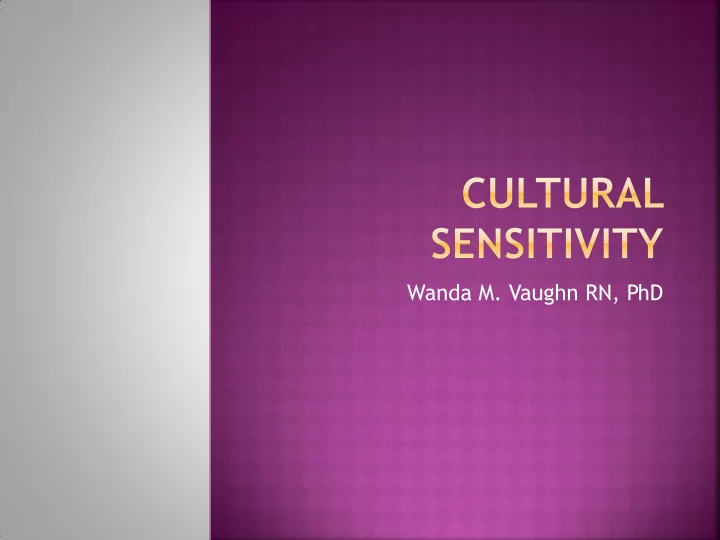

Wanda M. Vaughn RN, PhD
The participant will be introduced to: The definition of Cultural Sensitivity . Stages of Intercultural Sensitivity . Factors contributing to Mortality. Standards for development of Cultural and Linguistically Appropriate Care. Suggested Techniques for delivering Culturally and linguistically Appropriate Care.
What we have to do... is to find a way to celebrate our diversity and debate our differences without fracturing our communities. http://www.brainyquote.com/quotes/quotes /h/hillarycli163821.html#VJauVzqHq72rkCY4 .99 retrieved 12/4/2014
Awareness that cultural differences and similarities exist and can have an effect on values, learning and behavior Stafford, Bowman, Eking, Hanna, Lopoes-DeFede (1997) Knowing that cultural differences as well as similarities exist, without assigning values (i.e. better or worse, right or wrong) to those cultural differences . National Maternal and Child Health Center on Cultural Competency, 1997
I am not an expert Born in Lafayette, 18 mo later sister born in Japan, 18 mo later last daughter born in Albuquerque. Started school in England. Turned 13 in the Azores. Lived on military post until teens where playing field was more level. Visited with military Afghanistan, Guatemala, and Germany.
Developing a culturally competent attitude is an ongoing process. It is important to view all people as unique individuals and realize that their experiences, beliefs, values and language affect their ways of interacting with others and the larger community. Also, be aware that differences also exist within cultures. It is wrong to assume that a common culture is shared by all members of a racial, linguistic or religious group.
Galea et al, Estimated Deaths Attributable to Social Factors in the United States ,AJPH, August 2011, Vol 101, No. 8.
Source: U.S. Census Data. People Quick Facts. Retrieved Source: People Without Health Insurance Coverage by Race and Hispanic Origin Using 2- and 3-Year Averages: 2008- March 20, 2014 from 2009 and 2010-2011. U.S. Census Bureau, Current Population http://quickfacts.census.gov/qfd/states/00000.html Survey, 2009 to 2012 Annual Social and Economic Supplements. Distribution of US Population by Distribution of Uninsured by Race/Ethnicity 2012 Race/Ethnicity, 2010-2011
6 12 24 White 18 White Black Black Asian Asian Hispanic 15 Hispanic 27 12 6 Source: US Census Data. Quick facts. Retrieved Nov 5, 2014 from. http://factfinder2.census.gov/faces/tableservices/jsf/pages/productvi ew.xhtml?src=CF
16 7 4 5 4 White White Black Black 13 Asian Asian Hispanic Hispanic 74 87 Source: US Census Data. Quick facts. Retrieved Nov 5, 2014 from. http://factfinder2.census.gov/faces/tableservices/jsf/pages/productview .xhtml?src=CF
Provide effective, equitable, understandable, and respectful quality care and services that are responsive to diverse cultural health beliefs and practices, preferred languages, health literacy, and other communication needs. 1. Governance, Leadership and Workforce: 2. Advance and sustain organizational governance and leadership that promotes CLAS and health equity through policy, practices, and allocated resources. 3. Recruit, promote, and support a culturally and linguistically diverse governance, leadership, and workforce that are responsive to the population in the service area. 4. Educate and train governance, leadership, and workforce in culturally and linguistically appropriate policies and practices on an ongoing basis. Communication and Language Assistance: 5. Offer language assistance to individuals who have limited English proficiency and/or other communication needs, at no cost to them, to facilitate timely access to all health care and services. 6. Inform all individuals of the availability of language assistance services clearly and in their preferred language, verbally and in writing. 7. Ensure the competence of individuals providing language assistance, recognizing that the use of untrained individuals and/or minors as interpreters should be avoided. 8. Provide easy-to-understand print and multimedia materials and signage in the languages commonly used by the populations in the service area. Engagement, Continuous Improvement, and Accountability: 9. Establish culturally and linguistically appropriate goals, policies, and management accountability, and infuse them throughout the organization's planning and operations. 10. Conduct ongoing assessments of the organization's CLAS-related activities and integrate CLAS-related measures into measurement and continuous quality improvement activities. 11. Collect and maintain accurate and reliable demographic data to monitor and evaluate the impact of CLAS on health equity and outcomes and to inform service delivery. 12. Conduct regular assessments of community health assets and needs and use the results to plan and implement services that respond to the cultural and linguistic diversity of populations in the service area. 13. Partner with the community to design, implement, and evaluate policies, practices, and services to ensure cultural and linguistic appropriateness. 14. Create conflict and grievance resolution processes that are culturally and linguistically appropriate to identify, prevent, and resolve conflicts or complaints. 15. Communicate the organization's progress in implementing and sustaining CLAS to all stakeholders, constituents, and the general public. Retrieved from www.thinkculturalhealth.hhs.gov/Content/clas.asp Nov 2. CLAS=Cultural and Linguistically appropriate services.
One can never learn everything about another culture; however, there are practical, everyday steps we can take to develop our cultural awareness. Here are some suggestions: Develop awareness: take a look at your own biases and prejudices, become aware of cultural norms, attitudes, and beliefs, and value diversity; Don’t allow cultural differences (preferences) to become the basis for criticism and judgments. Differences are neither good nor bad – it is what we do with them that makes a difference; Build friendships of mutual respect and a desire for understanding; Be yourself and show that you care about the person and that you honestly want to help; Take time to listen. If you don’t understand, or you are not being understood, take the time to find out why. Explain or ask questions. For example, “Would you help me understand?” Acquire knowledge about other cultures by attending classes or seminars, reading books or watching movies about other cultures, and attending cultural events/festivals.
Recommend
More recommend